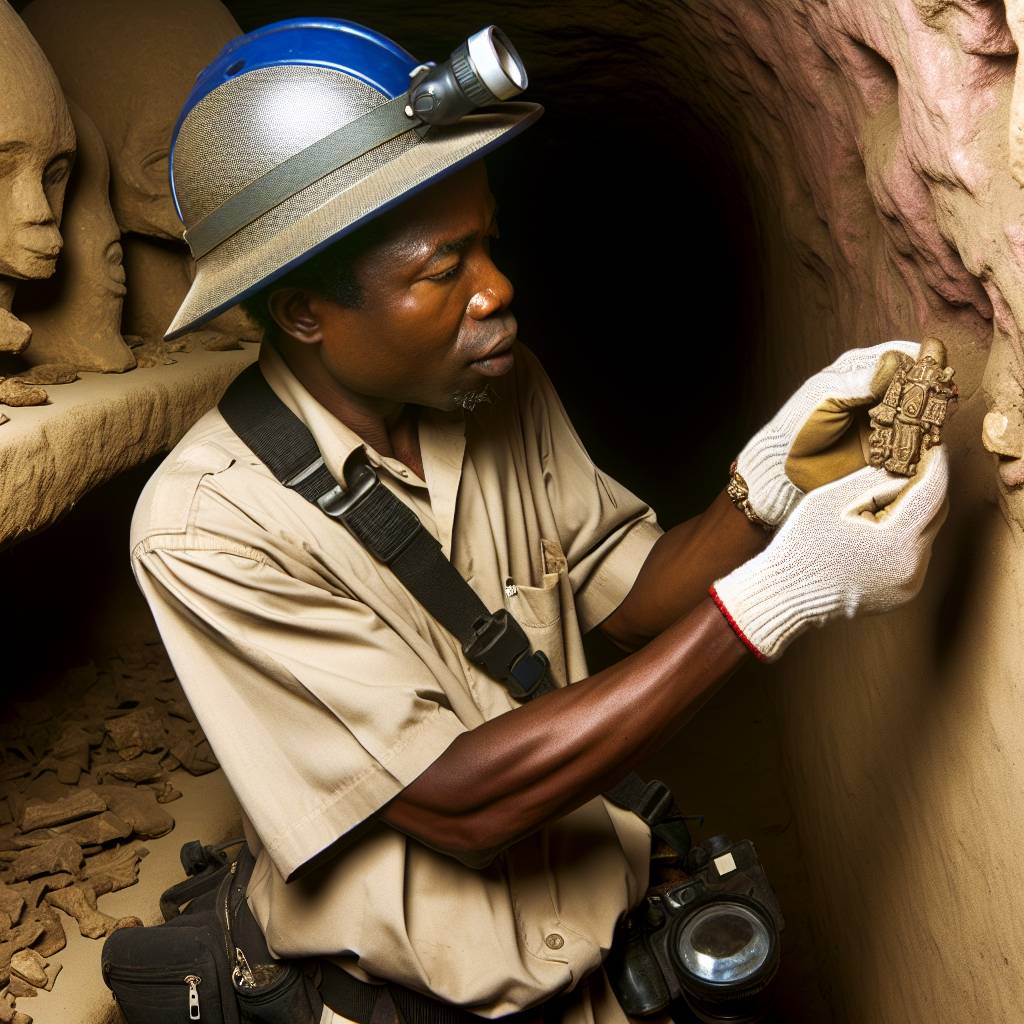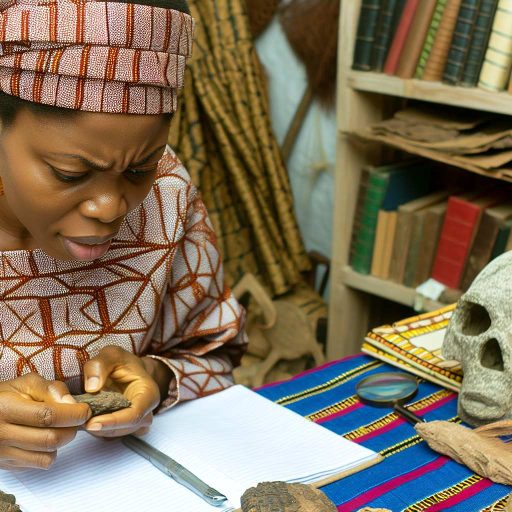Introduction:
A brief overview of the Nok Culture reveals a fascinating ancient civilization that thrived in what is now Nigeria.
Studying ancient civilizations in Nigeria is essential to understanding the rich history and cultural heritage of the region.
The Nok Culture holds significant importance in Nigerian history as it provides valuable insights into the early development of societies in the region.
Discovery of the Nok Culture:
Archaeologists first unearthed traces of the Nok Culture in the early 20th century near the village of Nok in central Nigeria.
These discoveries included terracotta figurines, pottery, and iron tools, showcasing the advanced craftsmanship and artistic skills of the Nok people.
Artistic Achievements of the Nok People:
The Nok Culture is renowned for its intricate terracotta sculptures, which depict human figures with elaborate hairstyles and accessories.
These artifacts demonstrate the artistic sophistication and cultural creativity of the Nok people, providing valuable clues about their beliefs and societal practices.
Technological Advancements of the Nok Civilization:
In addition to their artistic achievements, the Nok people were also skilled ironworkers, producing iron tools and weapons that were highly advanced for their time.
These technological advancements contributed to the economic prosperity and military strength of the Nok Civilization.
Legacy of the Nok Culture:
The legacy of the Nok Culture continues to intrigue scholars and historians today, offering a glimpse into the early origins of Nigerian societies.
By studying the Nok Civilization, we can gain a deeper understanding of the cultural heritage and historical development of Nigeria.
This highlights the importance of preserving and celebrating ancient civilizations for future generations.
Discovery of the Nok Culture:
Historical background of the Nok Culture
The Nok Culture was an ancient civilization that existed in what is now modern-day Nigeria.
It is believed to have thrived between 1500 BC and 500 AD, making it one of the earliest known civilizations in West Africa.
The Nok people were skilled in iron smelting and pottery making, creating intricate artifacts that showcased their artistic abilities.
They lived in small communities scattered across the Jos Plateau, engaging in agriculture and trade with neighboring societies.
Their artistic style, characterized by terracotta sculptures, is considered a hallmark of the Nok Culture.
Archaeological findings that led to the discovery of the Nok Culture
The Nok Culture was first discovered in 1928 by British archaeologist Bernard Fagg during a tin mining expedition.
Fagg stumbled upon a collection of terracotta sculptures and pottery shards that were unlike anything seen before.
These artifacts, ranging from life-sized human figures to animal sculptures, caught Fagg’s attention and sparked further investigation.
Excavations at various sites on the Jos Plateau revealed the extent of the Nok Culture’s influence and craftsmanship.
The discovery of iron smelting furnaces and clay quarries provided insight into the Nok people’s technological advancements.
Initial reactions and responses to the discovery
The discovery of the Nok Culture caused a stir in the archaeological community, as it challenged previous assumptions about West African history.
Scholars were amazed by the sophistication of the Nok people’s artistic expression and technological achievements.
The intricate details and lifelike qualities of the terracotta sculptures baffled researchers, who marveled at the skill of the ancient craftsmen.
The Nok Culture’s influence on subsequent West African civilizations, such as the Benin Empire, became apparent through further research.
Overall, the discovery of the Nok Culture opened up new avenues for understanding the region’s rich and diverse history.
Artifacts and Pottery Characteristic of the Nok Culture
The Nok people are known for their exquisite terracotta sculptures.
These sculptures are made using the coil method and are fired at high temperatures.
The Nok artifacts include human and animal figures, often with intricate details.
Their pottery is also highly decorated, featuring geometric patterns and designs.
The Nok culture is famous for its innovative use of iron smelting techniques.
Social Structure and Lifestyle of the Nok People
The Nok society was organized into a hierarchical structure.
At the top were the rulers and nobility, followed by craftsmen and traders.
Farming was the main occupation, with the Nok people cultivating yams, millet, and sorghum.
They also engaged in trade, exchanging their pottery and iron tools for goods such as salt and cloth.
The Nok people lived in small villages, with houses made of mud bricks and thatched roofs.
Religious Beliefs and Practices of the Nok People
The Nok people practiced animism, believing in spirits that inhabited natural objects.
They worshipped ancestral spirits and performed rituals to honor their ancestors.
Ceremonies were held to ensure a good harvest and protect the community from evil spirits.
Transform Your Career with Expert Guidance
Get personalized mentorship consulting that’s tailored to your unique path. Our expert advice is actionable and exclusive.
Get StartedThe Nok people also believed in the power of talismans and amulets to ward off evil.
Their spiritual practices were integrated into their daily lives, influencing everything from farming to trade.
Delve into the Subject: Case Studies: Geology Projects in Nigeria
Influence and Legacy of the Nok Culture:
When discussing the impact and legacy of the Nok Culture, it is essential to consider its influence on subsequent civilizations in Nigeria.
Its contribution to contemporary Nigerian art and culture also holds great significance.
Additionally, the challenges facing preservation efforts must be addressed.
Impact of the Nok Culture on Subsequent Civilizations in Nigeria:
- The Nok Culture is widely regarded as the earliest known civilization in Nigeria, dating back to around 1500 BC.
- The sophisticated iron smelting technology of the Nok people influenced later civilizations in Nigeria, such as the Yoruba and Igbo.
- Artistic traditions such as sculpting and pottery-making developed by the Nok Culture set the stage for future artistic expressions in Nigeria.
- The agricultural practices and trade networks established by the Nok people laid the foundation for economic growth in the region.
- The social and religious structures of the Nok Culture provided a framework for governance and spiritual beliefs that influenced subsequent societies.
Influence on Contemporary Nigerian Art and Culture:
- The iconic terracotta sculptures of the Nok Culture continue to inspire modern Nigerian artists and serve as a symbol of artistic heritage.
- Nigerian musicians, writers, and filmmakers often draw inspiration from the rich history and craftsmanship of the Nok civilization in their creative works.
- Contemporary Nigerian fashion designers incorporate motifs and patterns inspired by Nok artifacts into their designs, celebrating the cultural legacy of the ancient civilization.
- Art galleries and museums across Nigeria showcase Nok artifacts, raising awareness of the cultural significance of the ancient civilization among the Nigerian population.
- Art education programs in schools and universities in Nigeria include studies of the Nok Culture, ensuring that future generations recognize and appreciate the contributions of the ancient civilization.
Preservation Efforts and Challenges Facing the Nok Culture:
- Archaeologists and cultural heritage organizations are working to excavate and preserve Nok archaeological sites to safeguard the artifacts from looting and degradation.
- The lack of funding and resources poses a significant challenge to the preservation of Nok artifacts, making it difficult to conserve and protect these valuable cultural treasures.
- Climate change and environmental factors threaten the integrity of Nok archaeological sites, accelerating the deterioration of artifacts and endangering the cultural heritage of the civilization.
- Public awareness campaigns and educational initiatives are essential to promote the importance of preserving the Nok Culture and garner support for conservation efforts.
- International collaboration and partnerships with global heritage organizations can provide expertise and resources to enhance the preservation of Nok artifacts and promote cultural sustainability.
The Nok Culture has left a lasting legacy on the history, art, and culture of Nigeria.
It has influenced subsequent civilizations and shaped contemporary artistic expressions.
While efforts are being made to preserve the cultural heritage of the Nok civilization, challenges such as funding, climate change, and public awareness remain significant obstacles.
Addressing these issues is essential to safeguard the legacy of this ancient civilization for future generations.
Find Out More: Career Paths in Applied Biochemistry in Nigeria
Technological Advancements of the Nok Civilization
During the height of the Nok Civilization, the technological advancements of this ancient culture were quite impressive.
Metalworking and Advanced Iron Smelting Techniques
The Nok people were known for their expertise in metalworking, particularly iron smelting techniques.
They were able to produce intricate iron tools and weapons.
These included knives, spearheads, and other artifacts.
Their knowledge of metallurgy allowed them to create durable and functional items.
These items were essential for their daily lives and defense.
Agricultural Practices and Tools Used by the Nok People
In addition to their metalworking skills, the Nok people were highly adept at agriculture.
They utilized a variety of tools such as hoes, digging sticks, and planting sticks.
These tools helped them cultivate the land and grow crops such as yams, millet, and sorghum.
Their advanced agricultural practices enabled them to sustain a large population.
This allowed them to establish thriving communities throughout their territory.
Evidence of Trade Networks and Communication Systems
Archaeological evidence suggests that the Nok culture had extensive trade networks.
These networks allowed them to exchange goods and ideas with neighboring regions.
They traded items such as pottery, textiles, iron tools, and agricultural produce.
This indicates a sophisticated system of commerce and communication.
Such interaction with other cultures played a significant role.
It shaped the development and influence of the Nok civilization.
The technological advancements of the Nok culture were a testament to their ingenuity and resourcefulness.
Their mastery of metalworking, agricultural practices, trade networks, and communication systems laid the foundation for the success and longevity of this ancient civilization.
See Related Content: Nigeria’s Biodiversity: An Ecological Perspective

Decline and Disappearance of the Nok Culture
The decline and eventual disappearance of the Nok Culture, one of the oldest civilizations in Nigeria, remains a subject of much debate among historians and archaeologists.
Several theories have been put forward to explain the reasons behind the decline of this once-thriving society.
Theories and Speculations on the Decline of the Nok Culture
One of the prevailing theories suggests that environmental factors may have played a significant role in the decline of the Nok Culture.
Changes in climate patterns, including prolonged periods of drought or other natural disasters, could have led to food shortages and resource depletion, ultimately causing the collapse of the civilization.
Another popular speculation revolves around internal conflicts and social unrest within the Nok society.
It is believed that power struggles, political instability, and competition for resources among different factions within the community may have weakened the social fabric of the Nok Culture, leading to its eventual downfall.
Furthermore, some scholars argue that external invasions or attacks from neighboring tribes or civilizations could have also contributed to the decline of the Nok Culture.
These incursions may have disrupted trade routes, destroyed infrastructure, and destabilized the economy of the Nok people, hastening the disintegration of their civilization.
Overall, the exact reasons for the decline of the Nok Culture remain shrouded in mystery, with each theory offering a unique perspective on the factors that may have led to the disappearance of this ancient civilization.
Further archaeological discoveries and research may shed more light on this enigmatic chapter in Nigerian history.
Factors that May have Contributed to the Disappearance of the Nok People
Several factors have been identified as potential contributors to the disappearance of the Nok people and the decline of their once-thriving civilization.
These factors encompass a wide range of social, economic, and environmental elements that may have collectively led to the downfall of the Nok Culture.
One significant factor that could have played a role in the disappearance of the Nok people is the depletion of natural resources.
As the population grew and settlements expanded, the demand for resources such as water, timber, and arable land may have exceeded the region’s carrying capacity, leading to environmental degradation and resource scarcity.
Additionally, changes in climate patterns, such as periods of drought or extreme weather events, may have put further strain on the Nok society.
Crop failures, livestock losses, and water shortages could have disrupted agricultural practices and undermined food security, ultimately weakening the resilience of the Nok people in the face of environmental challenges.
Social factors, including internal conflicts, political instability, and social inequality, may have also played a role in the decline of the Nok Culture.
Tensions between different social groups, power struggles among elites, and issues of governance and leadership could have eroded the social cohesion and stability of the Nok society, making it more vulnerable to external threats and internal disruptions.
Overall, a complex interplay of environmental, social, and economic factors may have contributed to the disappearance of the Nok people and the decline of their civilization.
By examining these factors in conjunction with archaeological evidence, researchers can gain a better understanding of the historical forces that shaped the fate of the Nok Culture.
Legacy and Lasting Impact of the Nok Culture on Nigerian History
Despite its eventual decline and disappearance, the Nok Culture left a lasting legacy that continues to resonate in Nigerian history and culture to this day.
The unique artistry, technological advancements, and organizational skills of the Nok people have had a profound influence on subsequent civilizations in the region, shaping the course of Nigerian history in significant ways.
One of the most enduring legacies of the Nok Culture is its remarkable artistic tradition, particularly its distinctive terracotta sculptures.
These intricately crafted figurines, depicting human figures with elaborate hairstyles, jewelry, and clothing, showcase the artistic sophistication and creativity of the Nok people, setting a high standard for artistic expression in ancient Nigeria.
Furthermore, the technological innovations of the Nok Culture, including iron smelting, pottery making, and agricultural practices, laid the foundation for subsequent developments in the region.
The Nok people’s mastery of metalworking techniques, in particular, revolutionized the production of tools, weapons, and ceremonial objects, contributing to the material and cultural advancement of Nigerian societies.
In addition to their artistic and technological achievements, the organizational skills and social structures of the Nok people have had a lasting impact on Nigerian history.
The creation of complex settlements, the establishment of trade networks, and the development of hierarchical governing systems all demonstrate the sophistication and ingenuity of the Nok civilization, leaving a lasting imprint on the social and political landscape of Nigeria.
The Nok Culture, despite its decline and disappearance, has left an indelible mark on Nigerian history through its artistic, technological, and organizational achievements.
By studying the legacy of the Nok people, we can gain valuable insights into the cultural richness and historical significance of this ancient civilization, illuminating the enduring impact of the Nok Culture on the broader tapestry of Nigerian heritage.
Gain More Insights: Geology Internships and Industrial Training in Nigeria
Nok Culture’s Historical Significance
The Nok Culture holds immense significance in Nigeria’s history.
It showcases the advanced skills and cultural sophistication of its ancient inhabitants.
It is crucial to preserve and study ancient civilizations like the Nok Culture.
They provide valuable insights into the origins and development of society.
There is a pressing need for further research and exploration of Nigeria’s rich history.
Such efforts will help us fully understand the complexities of its past.




